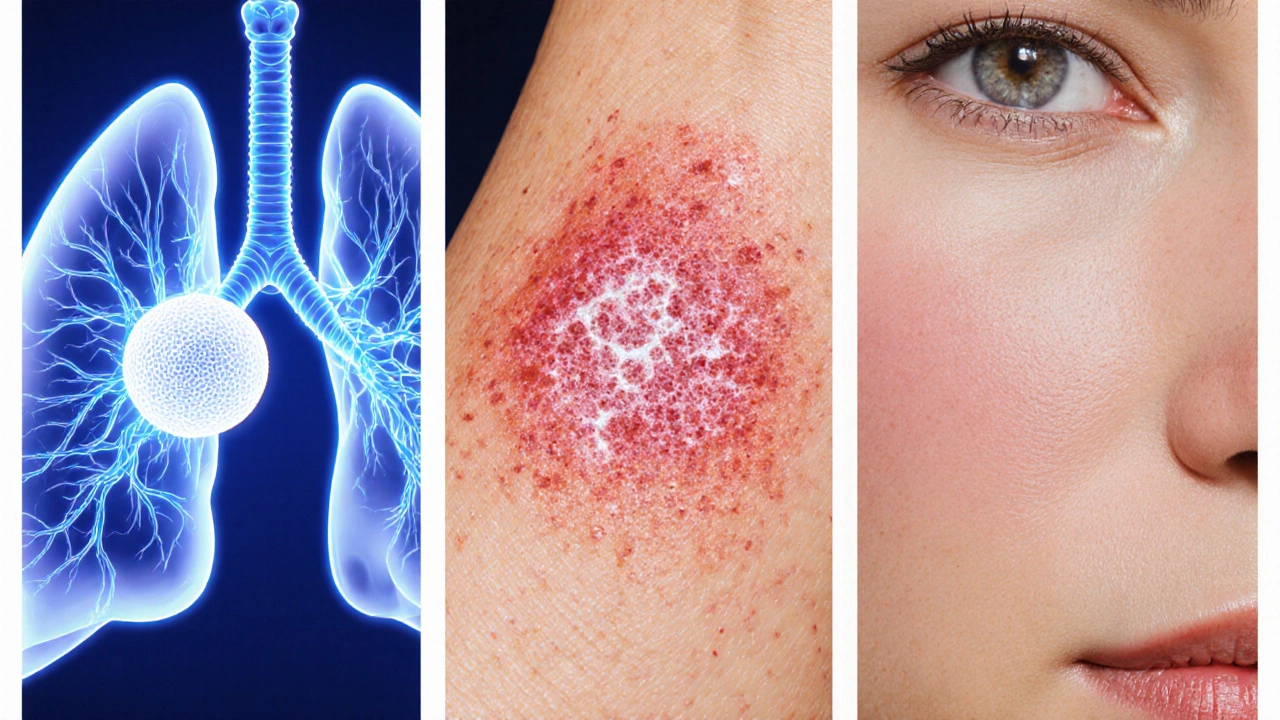Carcinoma vs Other Cancer Types
Legend:
Carcinomas account for about 90% of all malignant cancers because they originate from epithelial cells, which line most organs and body surfaces. These cells are abundant throughout the body, making carcinomas the most common type of cancer.
The three major subtypes are:
- Adenocarcinoma: Arises from glandular epithelial cells (e.g., lung, breast, colon)
- Squamous cell carcinoma: Originates from flat, scale-like cells (e.g., skin, esophagus)
- Basal cell carcinoma: Develops from basal cells in the skin's deepest layer
Unlike other cancer types like sarcomas (from connective tissues) or leukemias (from blood-forming cells), carcinomas have a much higher incidence due to the widespread presence of epithelial cells.
Key Takeaways
- About 90% of all malignant cancers are carcinomas.
- Carcinomas arise from epithelial cells that line organs and skin.
- The main sub‑types are adenocarcinoma, squamous cell carcinoma and basal cell carcinoma.
- Other cancer groups - sarcomas, leukemia and lymphoma - together make up the remaining ~10%.
- Early detection, lifestyle choices and targeted therapies significantly improve outcomes.
When you hear the word "cancer" it’s easy to think of a single disease, but medically it’s a collection of many different disorders. If you’re wondering what accounts for the lion’s share of cases, the answer is Carcinoma is a type of malignant tumor that originates in epithelial cells - the cells that line the inside and outside of every organ in the body. Roughly nine out of ten cancers you’ll hear about, from lung to breast, are carcinomas.
Below we break down why carcinomas dominate the statistics, what their main sub‑categories are, how they differ from other malignancies like Sarcoma a cancer of connective tissues such as bone, cartilage, fat or muscle, and what practical steps you can take to lower your risk.
What Exactly Is a Carcinoma?
A carcinoma starts when the DNA of an epithelial cell gets damaged and the cell begins to grow uncontrollably. Because epithelium covers most of the body’s surface area - skin, lung airways, gastrointestinal tract, breast ducts, prostate glands - carcinomas have a huge playground, which explains their high incidence.
In contrast, Cancer a broad term for any uncontrolled cell growth that can invade other tissues includes many other groups that arise from different cell origins. But when clinicians talk about "cancer" in everyday conversation, they are most often referring to carcinomas.
How Common Are Carcinomas?
Global cancer registries, such as those compiled by the International Agency for Research on Cancer (IARC), consistently report that about 90% of all diagnosed malignant neoplasms are carcinomas. For example, the 2023 worldwide cancer data set recorded 19.3million new cancer cases, of which approximately 17.4million were classified as carcinomas.
The remaining 10% includes Leukemia cancers that begin in the blood‑forming tissue of the bone marrow, Lymphoma malignancies of the lymphatic system, including Hodgkin and non‑Hodgkin types, and the previously mentioned sarcomas.

Major Sub‑Types of Carcinoma
While all carcinomas share an epithelial origin, they differ in the specific cell type and the organ they affect. The three most prevalent sub‑types are:
- Adenocarcinoma tumors that arise from glandular (secretory) epithelial cells. Common sites: lung, colon, pancreas, prostate, breast.
- Squamous cell carcinoma originates from squamous epithelial cells, which are flat and scale‑like. Common sites: skin, esophagus, cervix, head and neck.
- Basal cell carcinoma arises from basal cells in the lowest layer of the epidermis. Most frequent skin cancer, especially in sun‑exposed areas.
Each sub‑type behaves differently. Adenocarcinomas often spread through blood vessels, while squamous cell carcinomas may infiltrate nearby tissues more aggressively. Basal cell carcinoma, despite being common, rarely metastasizes.
Why Other Cancer Types Are Much Less Common
Non‑epithelial cancers originate from cell lines that are less abundant in the body. For instance, Sarcoma tumors of mesenchymal origin such as bone, cartilage, fat, and muscle accounts for only about 1% of adult cancers. Their rarity reflects the smaller population of mesenchymal cells compared with epithelial cells.
Similarly, blood‑related cancers like Leukemia a malignancy of immature blood cells and Lymphoma cancers that develop in lymph nodes and lymphatic tissue together make up around 5% of all cases. Their development depends on mutations in the hematopoietic stem cell compartment, which is a more specialized environment.
Risk Factors Specific to Carcinomas
Because carcinomas arise from the body's lining, many external exposures directly affect them:
- Tobacco smoke - the leading cause of lung adenocarcinoma and squamous cell carcinoma of the head and neck.
- UV radiation - drives basal cell carcinoma and squamous cell carcinoma of the skin.
- Alcohol - linked to squamous cell carcinoma of the esophagus and oral cavity.
- Dietary factors - high‑fat, low‑fiber diets increase risk of colorectal adenocarcinoma.
- Chronic infections - Helicobacter pylori (stomach adenocarcinoma), Human papillomavirus (cervical squamous cell carcinoma).
Genetic predisposition also plays a role. Families with BRCA1/2 mutations see higher rates of breast and ovarian adenocarcinomas, while Lynch syndrome raises the chance of colorectal adenocarcinoma.
How Carcinomas Are Diagnosed and Treated
Early detection dramatically improves survival. Common screening tools include:
- Mammography for breast adenocarcinoma.
- Low‑dose CT scans for lung cancer in high‑risk smokers.
- Colonoscopy for colorectal adenocarcinoma.
- Dermatologic exam for skin basal and squamous cell carcinomas.
Once a lesion is spotted, a biopsy confirms the histologic subtype. Pathologists look for specific markers - for example, KRAS or EGFR mutations in lung adenocarcinoma - that guide targeted therapy.
Standard treatment pillars are surgery, radiation, and systemic therapy (chemotherapy, immunotherapy, targeted agents). The exact mix depends on stage, location, and molecular profile. For many early‑stage adenocarcinomas, surgical removal alone can be curative.
Prevention Tips You Can Apply Today
Because lifestyle influences epithelial cells heavily, simple changes can cut your risk:
- Quit smoking - the risk drops by half within a few years and continues to fall.
- Use sunscreen with SPF30+ and wear protective clothing outdoors.
- Limit alcohol to moderate levels (up to one drink per day for women, two for men).
- Eat a balanced diet rich in fruits, vegetables, whole grains, and lean proteins.
- Stay up to date with recommended cancer screenings based on age and family history.
Quick Reference: Cancer Types vs. Global Prevalence
| Cancer Group | Approx. % of All Cancers | Common Sites |
|---|---|---|
| Carcinoma | ~90% | Lung, breast, colon, prostate, skin |
| Sarcoma | ~1% | Bone, soft tissue, cartilage |
| Leukemia | ~2% | Blood, bone marrow |
| Lymphoma | ~3% | Lymph nodes, spleen |
| Other Rare Tumors | ~4% | Various organs |
Frequently Asked Questions
Why do carcinomas make up such a high percentage of cancers?
Epithelial cells line the surface of almost every organ, providing a large field for DNA damage and uncontrolled growth. This anatomical abundance translates into a higher likelihood of malignant transformation compared to other cell types.
Can a carcinoma become a sarcoma or vice‑versa?
No. Carcinomas and sarcomas arise from fundamentally different cell lineages-epithelial versus mesenchymal. However, a tumor can contain mixed features (carcinosarcoma), which is a rare hybrid.
Is basal cell carcinoma dangerous?
Basal cell carcinoma rarely spreads to other organs, but it can cause local tissue damage if left untreated. Early removal usually cures it completely.
How reliable are cancer screening tests for detecting carcinomas early?
Screening programs like mammography, low‑dose CT, colonoscopy, and skin exams have proven to catch cancers at stages when surgery or less‑intensive therapy can achieve high cure rates. Their effectiveness depends on adherence to recommended intervals and proper technique.
What new therapies are changing the outlook for carcinoma patients?
Targeted drugs (e.g., EGFR inhibitors for lung adenocarcinoma) and immune checkpoint inhibitors (e.g., pembrolizumab for many solid tumors) have extended survival for patients with advanced disease, turning some once‑fatal diagnoses into chronic, manageable conditions.
Understanding that carcinoma drives the majority of cancer cases helps you focus on the most effective prevention and early‑detection strategies. Stay informed, get screened, and adopt healthier habits - they’re your best defense against the most common form of cancer.



